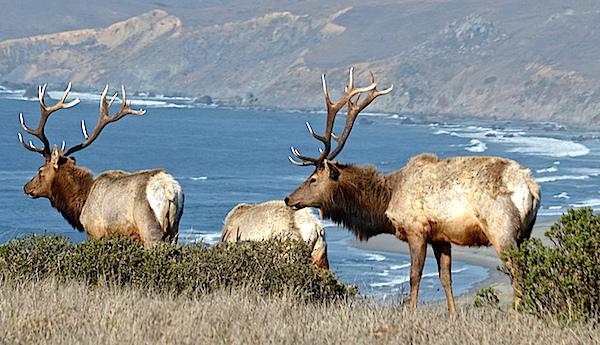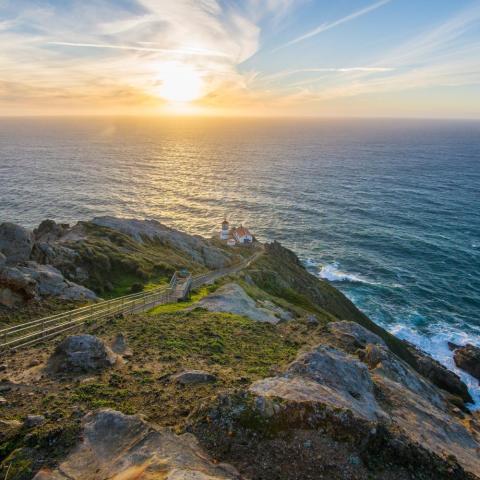
The population of one herd of Tule elk at Point Reyes National Seashore has declined precipitously, drawing charges of mismanagement/David McSpadden via flickr
Charges of wildlife mismanagement by the staff at Point Reyes National Seashore are being leveled in the wake of the deaths of more than 200 Tule elk caused, apparently, by a lack of water inside their fenced preserve.
While park biologists point to California's long-running drought as a primary cause for the deaths of more than 250 elk between 2012 and 2014, staff at the Center for Biological Diversity note that elk at the seashore that are not penned in have been enjoying a population boom of sorts.
"Tule elk need room to roam, and native wildlife in our national park should not be fenced in or prevented from finding water and food," said Jeff Miller with the Center. "The loss of nearly half the Pierce Point elk herd highlights how important it is that the Park Service not cave to commercial ranchers who want free-roaming Point Reyes elk fenced in."
Point Reyes is just the latest National Park System unit enmeshed in wildlife issues spurred by a lack of space. At Yellowstone National Park the plight of bison, which are killed by the hundreds each year when they roam out of the park and into Montana, has been well-documented. At Cape Hatteras National Seashore in North Carolina the Park Service has been castigated for fencing off large areas of beach to allow for nesting piping plovers, a threatened species. Culling operations for elk and deer have been used at Rocky Mountain National Park in Colorado, Wind Cave National Park in South Dakota, Cuyahoga Valley National Park in Ohio, and Valley Forge National Historical Park in Pennsylvania, just to cite a few examples.
Dave Press, a wildlife ecologist at Point Reyes, said Friday afternoon that the ongoing drought that has gripped California for four years now contributed greatly to the die-off of the herd that lives within a 2,600-acre fenced-in preserve on Tomales Point.
"Considering we are in one of the worst droughts in Californial history, it doesn't surprise us that there were impacts to the Tule elk up at Tomales Point," he said. "I think the presence of the fence contributed to the severity of those impacts. The free-range elk, just by the nature of where they occur, they are associated with areas that have year-round water supplies. Creeks that flow year-round, ponds.'
The preserve was created in 1978 when an elk recovery program brought 10 animals to Tomales Point, explained the wildlife ecologist.
"We didn't want to put 10 elk out there and then just have those elk go their separate ways, not breed, not establish and create a robust herd," said Mr. Press.
Concerns that Tule elk might overlap with cattle on the point spurred the decision to keep the herd fenced in, he added.
Now, however, the die-off likely will fan controversy as the Park Service develops a ranch management plan for the national seashore. There are, Mr. Press said, about 22 ranching operations on the national seashore and neighboring Golden Gate National Recreation Area. While the ranches are on Park Service land, they existed before the national seashore was created.
"Part of the main reason the park is here was because of that partnership that was reached between the conservationists and ranching interests," the ecologist explained.
When former-Interior Secretary Ken Salazar visited Point Reyes in 2012 to look into the propriety of an oyster farm operating in the seashore on land tagged to become wilderness, he issued a memorandum authorizing the Park Service to pursue long-term lease/permits for dairy and beef ranching operations that operate on roughly 28,000 acres of the national seashore.
Now the Center for Biological Diversity, against the backdrop of the elk die-off, is criticizing the planning effort.
Cattle ranchers who enjoy heavily subsidized cattle grazing leases on public lands within the national seashore are lobbying the Park Service to remove or fence out the free-roaming elk from ranching areas, because elk are eating grass they believe should be reserved solely for their cattle. The Park Service is considering evicting the free-roaming elk under a planning process initiated for 28,000 acres of leased dairy and beef cattle ranches within the park and Golden Gate National Recreation Area lands in Marin County administered by the national seashore. The Park Service is also proposing extending ranching leases for up to 20 years, and may allow ranchers to expand their operations to animals other than cattle, which would create more conflicts between livestock and native wildlife.
At the national seashore, Mr. Press said a number of alternatives are being discussed. While some call for more fencing of elk, or fencing-out of cattle pastures, others identify culling as one action. A draft plan for public review is expected late this year, he said.
Tule elk are native and endemic to California. There were once 500,000 tule elk in the state but by the late 1800s impacts from cattle ranching and hunting had reduced them to only 28 elk, according to a release from the Center for Biological Diversity. From one surviving herd, Tule elk were reintroduced throughout the state and there are now 4,300 elk in 25 herds. Tule elk were returned to Pierce Point at Point Reyes in 1978, and a free-ranging herd was established in the park in 1998. Point Reyes Seashore is the only national park with tule elk.
According to the Center, the Pierce Point herd declined from 540 elk in fall of 2012 to 286 elk by 2014, a drop of 47 percent. There are no natural year-round fresh water sources on Pierce Point and the elk in the preserve are prevented from migrating by a large, elk-proof fence, the organization adds. During the same drought period, the free-roaming Point Reyes elk herds 'which had access to water ' increased by 32 percent. The Limantour herd grew from 94 to 120 elk and the Drakes Beach herd increased from 66 to 92 elk.
"The reintroduction of elk to the Point Reyes peninsula is a success story for conservation of native species, but the elk are in jeopardy of eviction to benefit a few lease holders," said Mr. Miller. "The Park Service already prioritizes commercial cattle grazing in Point Reyes. Now these subsidized ranchers want to dictate park policies that could eliminate native elk and harm predators and other wildlife."
According to the Center, "(T)here are 13 cows for every elk in the national seashore, with nearly 6,500 dairy and beef cattle and only 498 elk. One-quarter of the national seashore is devoted to commercial cattle operations, with grazing on nearly 18,000 acres under 39 leases. Ten ranching families were paid $19.6 million by the public from 1963 to 1978 for the purchase of ranch lands added to Point Reyes National Seashore. Many of those same families still enjoy heavily subsidized grazing lease rates within the park, paying one-half to one-third the cost they would pay for non-federal grazing land in Marin."












Comments
Ecbuck
Their actions established their intent for me, which were designating the area as potential wilderness and setting a date for removing the main impediment from establishing it as a wilderness area.
And I don't think the agreement should be ignored but I also think the elk should be allowed to go where they want to go. This will be one for the lawyers.
http://parkadvocate.org/commercial-beef-cattle-in-americas-national-park...
I'll go with what they said they intended over your interpretation of their actions:
http://www.marinij.com/general-news/20110813/former-legislators-back-poi...
In regards to the oyster farm, do you think its okay for the NPS to misrepresent the available scientific information? Does these ends justify the means?
I can think of at least one other park where this was done, right Buxton?
Of course that isn't right. Blowing up people and pouring millions of gallon of crude in the gulf isn't right either, the world is full of wrongs.
Nothing should have been a surprise to the former tenants at Drakes Bay.
http://www.nps.gov/pore/learn/management/upload/planning_dboc_sup_background_sup_080422.pdfs)
The former tenants signed a lease that spelled out clearly when the lease was over.
Yes, the lease was over but there was no reason it couldn't be renewed. As explicitly stated by the bills sponsors, it was not their intent to kick the Oyster business out - ever.
If everyone knew this was going to happen then why did the expend so much effort to smear and deceive everyone? Why would they risk thier credibility?
I wonder if any thode deceitful NPS biologists were reprimanded in any way and are they involved in this fiasco?
BTW - I don't consider posts and string a fence, it doesn't constrain these birds to an area.
As of right now, these posts and string are being unnecessarily used to close off human access to the highly popular Cape Point beach for not endangered, not threatened, birds that have possibly shown breeding behavior.